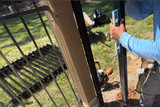Understanding Core Drilling and Floor Mounting Brackets for Aluminum Fence Posts
When installing aluminum fence posts, two primary methods are commonly used: core drilling and floor mount brackets. Each technique has its own advantages and is suited for different installation environments and needs. Understanding the differences between these methods can help you choose the right one for your project.
Core Drilling: A Deep Dive
What is Core Drilling?
Core drilling involves creating a cylindrical hole in a solid surface, such as concrete or stone, to insert the fence post. This method requires specialized equipment to drill precise, clean holes.
Advantages of Core Drilling
- Stability and Strength: Core drilling provides a robust and stable base for fence posts. The posts are inserted into deep holes and secured with concrete, ensuring they remain firmly in place.
- Aesthetics: The finished look is seamless and clean, with no visible mounting hardware. This makes core drilling an excellent choice for high-end or aesthetically focused projects.
- Durability: Posts installed via core drilling are less susceptible to environmental wear and tear. The deep-set installation offers better resistance to wind and other forces.
Disadvantages of Core Drilling
- Complexity: The process requires specialized equipment and skilled labor, which can increase installation costs.
- Time-Consuming: Core drilling is more time-intensive compared to other methods. The precise drilling and setting of posts require careful attention to detail.
- Surface Damage: Drilling into concrete or stone surfaces can cause damage if not done correctly, and repairs can be costly.
Floor Mounting Brackets: A Surface-Level Solution
What are Floor Mounting Brackets?
Floor mounting brackets are metal plates that are attached to a flat surface, such as a concrete slab or wooden deck. The fence posts are then attached to these brackets, securing them in place.
Advantages of Floor Mounting Brackets
- Ease of Installation: This method is generally simpler and quicker. It requires basic tools and less technical skill, making it accessible for DIY enthusiasts.
- Flexibility: Floor mounting brackets can be easily adjusted or replaced if needed. This makes them a versatile option for areas that may require future modifications.
- Cost-Effective: Since the installation process is less labor-intensive and does not require specialized equipment, it can be more affordable than core drilling.
Disadvantages of Floor Mounting Brackets
- Stability Concerns: Floor-mounted posts may not be as stable as those installed via core drilling, especially in high-wind and high-traffic areas. The brackets are only as strong as the surface they are mounted on.
- Aesthetic Impact: The brackets are visible, which may not be desirable for projects where a seamless look is preferred.
- Durability Issues: Over time, the brackets and bolts can corrode or loosen, potentially compromising the integrity of the fence.
Choosing the Right Method
The choice between core drilling and floor mounting brackets depends on several factors, including:
- Project Environment: Core drilling is ideal for solid, stable surfaces, while floor mounting brackets work well on flat, even surfaces.
- Budget: Floor mounting brackets are generally more budget-friendly, whereas core drilling can be more costly due to labor and equipment requirements.
- Aesthetic Preferences: For a clean, hardware-free look, core drilling is the better option. If visibility of brackets is not a concern, floor mounting brackets are suitable.
- Long-Term Durability: Core drilling offers superior long-term stability, making it suitable for projects requiring maximum durability.
Conclusion
Both core drilling and floor mounting brackets offer viable solutions for installing aluminum fence posts. Core drilling provides unmatched stability and a seamless finish but comes at a higher cost and complexity. Floor mounting brackets offer ease of installation and flexibility but may compromise on stability and aesthetics. By considering the specific needs and constraints of your project, you can choose the method that best suits your requirements, ensuring a successful and lasting installation.
Recent Posts
-
Experience, Reputation, Customer Service
Here’s why buying from OnlineFenceStore.com is a strong choice for fencing products: Key Advantages …Aug 13th 2025 -
How to Order Fence from OnlineFenceStore.com: A Step-by-Step Guide
How to Order Fence from OnlineFenceStore.com: A Step-by-Step Guide Ordering a fence online has never …Jul 30th 2025 -
Plumb vs. Level: Understanding the Difference in Fence Post Installation
When it comes to installing a fence, getting the job done right the first time is crucial. One of th …Jun 19th 2025







